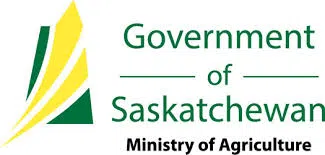EAST CENTRAL SASKATCHEWAN
Producers in the east-central region are currently working to apply fungicides and insecticides to protect certain crops. Sporadic rainfall aided crop development in some areas, but much of the east-central area received minimal rain and crops are in need of timely moisture.
The Hanley area received 44 mm of rain, which was the most in the province. The Serath area recorded the second-highest rainfall with 33 mm, followed by the Semans area with 28 mm. The Jansen and Outlook areas also recorded notable rainfall with 27 mm and 25 mm, respectively.
With limited rainfall in many parts of the east-central region, topsoil moisture fell slightly last week. Cropland topsoil moisture is rated at 71 per cent adequate, 26 per cent short, and three per cent very short. For hayland, topsoil moisture is rated as 62 per cent adequate, 36 per cent short, and two per cent very short. Finally, pasture topsoil moisture is rated as 58 per cent adequate, 37 per cent short, and five per cent very short.
Some crop emergence in the spring was uneven due to early season dry conditions and is causing inconsistent crop stages in fields. Currently:
- Four per cent of winter cereals are tillering, two per cent are at flag leaf stage, 40 per cent are heading, and 50 per cent are at dough stages.
- One per cent of spring cereals are in the seedling stage, six per cent are tillering, 10 per cent are at stem elongation, 31 per cent are at flag leaf, 51 per cent are heading, and one per cent are in dough stage.
- Twelve per cent of flax remains in the seedling stage, 71 per cent are in stem elongation, and 17 per cent are flowering.
- Four per cent of canola and mustard crops are in the seedling stage, 12 per cent are at the rosette stage, 30 per cent are bolting, and 54 per cent are flowering.
- Nineteen per cent of pulse crops are in vegetative stages, 78 per cent are flowering, and three per cent have podded.
The east-central region has some of the best pasture conditions in the province. Currently, one per cent of pastures are in excellent condition, 45 per cent are good, 36 per cent are fair, 17 per cent are poor, and only one per cent are in very poor condition.
Livestock producers are making good progress in their haying efforts as 24 per cent of the hay crops have been cut. Additionally, 11 per cent have been baled or silaged and 65 per cent of hay is still standing and waiting for its first cut. Producers are also reporting that the hay quality from the first cut is good overall. Four per cent of the hay is excellent quality, 65 per cent is good, 28 per cent is fair, and only three per cent is poor quality.
Dry conditions are causing the most crop damage, but most of the damage reported is minor to moderate. The east-central region experienced warm temperatures last week which caused minor to severe damage to some crops. Wind and wildlife activity caused minor to moderate damage in certain crops as well. There were some isolated thunderstorms which brought hail and resulted in minor damage to a few crops. Like much of the province, cabbage seed pod weevil is causing the most insect damage to crops with damage considered to be minor to severe in oilseed crops. A few producers are still seeing minor flea beetle damage to less developed oilseed crops.
SOUTHEAST SASKATCHEWAN
Crops in the southeast look promising in many areas and producers would like to see additional timely rains to continue supporting crop development. Parts of the southeast continue to receive modest rainfall that is causing producers to spray fungicides to certain pulse, cereal, and oilseed crops. Other areas in the southeast have been experiencing dry conditions for the past two weeks and fungicides haven’t been needed yet.
The highest rainfall was in the Lampman area, which received 32 mm of rain. The Hirsch area received 25 mm, while the Griffin area got 23 mm of rain. Other areas that received notable rainfall include the Lajord area with 22 mm and Balcarres area with 21 mm.
Topsoil moisture levels fell slightly from last week in the southeast as there wasn’t enough rain to replenish moisture loss. Cropland topsoil moisture is 69 per cent adequate, 30 per cent short, and one per cent very short. Hayland topsoil moisture is 63 per cent adequate, 33 per cent short, and four per cent very short. Pastures have similar soil moisture levels with 63 per cent having adequate moisture, 32 per cent are short, and five per cent are very short.
As we move into July, timely rainfall is needed to accompany hot weather for crops to advance consistently. Currently:
- Two per cent of winter cereals are in stem elongation, two per cent are at the flag leaf stage, 50 per cent are heading, 40 per cent are in dough stages, and six per cent are ripe.
- Seven per cent of spring cereals are tillering, 18 per cent are in stem elongation, 31 per cent are at flag leaf stage, 42 per cent are heading, and two per cent are at dough stages.
- Three per cent of flax remain in seedling stages, 67 per cent are in stem elongation, 23 per cent are flowering, two per cent are at the boll stage, and 5 per cent are ripe.
- Three per cent of canola and mustard are in the seedling stage, 19 per cent are in the rosette stage, 27 per cent are bolting, and 51 per cent are flowering.
- Three per cent of pulse crops are still seedlings, 22 per cent are in vegetative stages, 69 per cent are flowering, and six per cent have podded.
Pasture conditions in the southeast are some of the best in the province this year. Currently, six per cent of pastures are in excellent condition, 46 per cent are in good condition, and 38 per cent are in fair condition. Only nine per cent are considered poor and one per cent considered very poor.
Haying is in full swing, with 32 per cent of hay being cut for the first time this year. Fourteen per cent of hay has been baled or silaged while 54 per cent remains standing. Producers are reporting that hay in the southeast is the highest quality in the province with 21 per cent being excellent quality, 53 per cent being good, 20 per cent being fair, and six per cent being poor quality.
Crop damage differs throughout the southeast. Dry conditions are the biggest concern, with some areas reporting minor to severe damage. Damage from other environmental sources such as wind and heat are causing minor to moderate damage. Wildlife damage ranges from minor to severe in some crops, with gophers being the main source of wildlife damage. Finally, insect activity is low in the southeast, but cabbage seed pod weevils are causing minor to moderate damage in some oilseed crops.
– Saskatchewan Agriculture
















Comments